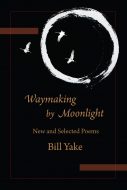 Bill Yake
Bill Yake
Waymaking by Moonlight: New and Selected Poems
Empty Bowl
Reviewer: Vivian Wagner
Bill Yake’s Waymaking by Moonlight is a collection of poems exploring the interrelatedness of people, culture, and wilderness. Ultimately, the poems describe a continuum between humans and the natural world, suggesting that they cannot be extricated from each other.
Divided into sections, each with its own theme, spirit, and landscape, such as “Flecks, Hints, and Intuitions,” “Cohorts,” “Reverent and Irreverent Prayers,” “Desert and Steppe Poems,” “Forest, Mountain, and Water Poems,” and “The Urban Mask,” the collection meanders through a life lived in both wild places and cityscapes, away from human culture and embedded in it.
The poems all share a meditative quality, inspired by the poetry of nature poets and writers, from Walt Whitman to Gary Snyder, and they’re all about wandering and making one’s way through the world. As Yake says in his preface,
A book is a trail the mind walks. A trail is a tale, a sequence the eye can read …. These poems are offered in that spirit—attention paid to the world and markers placed by previous travelers: to the painted marks made by those who walked the desert before us, to the footprints cast in stone by ancient families tracking through tidal flats, and to the library codes on book spines.
It is a book about waymaking, about finding one’s way, and about reporting on what one finds along that way: “May each of us endure to record and map our journeys—then to pass the findings along,” Yake says. As findings, Yake’s poems report on herons and deserts, forest streams and cliffs, zoos and grandchildren. They’re both a celebration of life and a meditation on death, simultaneously adventure-seeking and inward-facing.
The first poem in the collection, “Waymaking by Moonlight,” in a section called “Invocations,” opens with a meditation on the moon:
Tonight, the moon is weighted light
and shadow. When she arose opposite
the sun setting, she lit—as she rose—
in a single moment—basin and range,
wave summit and trough, plinth and pillar.
It’s a moment of revelation and mystery, with the light of the moon revealing as much as it hides, and it’s a fitting beginning to a collection that itself casts a complex and subtle light on the intricacies of the world. The poem admits that the light from the moon won’t be enough to see everything; the reader must also pay attention to their own paths: “Watch your step,” the speaker says, indicating that the reader must become their own witness to the mysteries unfolding in front of them.
The next section, “Flecks, Hints, and Intuitions,” collects short poems and meditations on nature and human interactions with it. One poem, “inside out,” depicts the echoes between humans and the natural world:
trees are our lungs turned inside out
& inhale our visible chilled breath
our lungs are trees turned inside out
& inhale their clear exhalations.
That trees and lungs resemble each other and inhale each other’s exhalations demonstrates the interconnectedness of humans with the environment, and the ways in which we are always at home in the world, even when we might feel lost.
Another section, “Cohorts,” explores interconnections between humans themselves, as beings that share a responsibility for and understanding of each other. One poem, “Granddaughter One,” looks at the biological magic trick of conceptions and birth:
Like a footprint
or laurel branch,
you are something
where a year ago
there was nothing.
The speaker as grandfather marvels at this baby, “a handful and a heartbeat / from mere potential,” and at the “miracle—biology” that brought that baby into existence.
Several of the book’s sections look at specific ecosystems, such as deserts and forests, considering the truths they reveal about themselves and the humans who wander through them. In a section on deserts, for instance, a poem called “Into the Desert” describes the process of leaving human culture behind to enter a remote wilderness: “Portland radio fades to road noise— / the latest news—John Cage is dead.” The speaker finds solace, comfort, and beauty in that wilderness, however: “I slide the canopy windows open; the wind shakes / & blows a whole night of sage overhead.”
Throughout this collection, nature offers exactly what humans need: a respite, as well as a reminder that all things—humans and sand, culture and sage—are connected
In a section called “Brambles and Thorns—Ecopolitical Poems,” the poet explores political themes, such as climate change and overfishing. The poems in this section, however, transcend easy answers and ponder deep and abiding questions about humanity’s relationship with the earth.
In “Letter to America—A Version in Which a Mirror Shatters,” the Whitmanesque speaker explores what America is in the twenty-first century—and the damage it’s doing to itself, its people, and the earth:
I came to notice your age, your eroding banks, gasfield tremors, your young men old too soon slumped in alleyways like clear-cut slopes too soaked with rain. Your springs too full of trash, your falls gone dry and crackling, wildfires in your beetle-killed pines.
The poem is at once an elegy and a celebration, filled with a longing for what this land could be and what, as a result of human misuse, it is. It’s also a plea for the country to become better, to find itself: “I who am you, beg you who am I—pull yourself, America, together.”
The collection’s last section is called “Mortality,” and it picks its way around personal, cultural, and ecological deaths, trying to find some kind of hope in the midst of near-apocalypse. The last poem, “Heart Poem,” looks at the simultaneous fragility and strength of the human heart, in the midst of a heart attack and surgery:
Linked by blood and tasked by flesh it beats and beats
and pauses.
Perhaps
to beat again.
It’s an ending that speaks not simply about a particular human heart, but the human heart more broadly and collectively. And it leaves open the possibility that this heart might, finally, make its way toward beating again.

